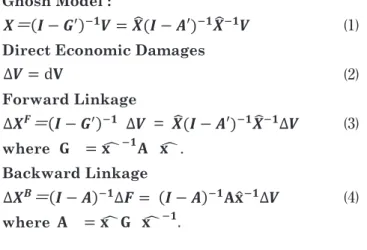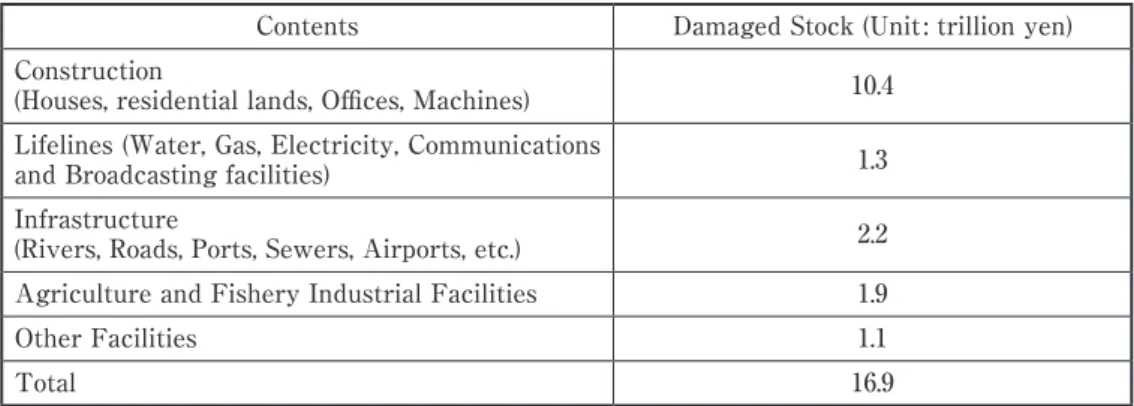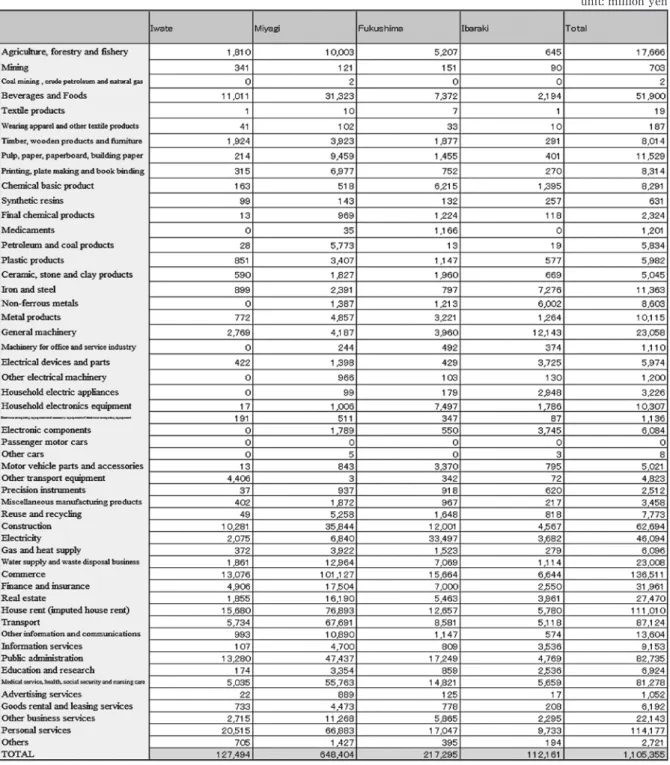− 23 −
How to Examine the total economic impact, stemmed from the Great East Japan Earthquake:
within the Interregional Input-Output Framework
Michiya NOZAKI ※
※
Visiting Researcher, Graduate school of Hirosaki University, 1, Bunkyo-cho, Hirosaki, Aomori, Japan, 036-8560.
E-mail : michi_post@kfx.biglobe.ne.jp Abstract:
The purpose of this study is to examine the total economic impact caused by the Great East Japan Earthquake within the Interregional Input-Output Framework.
The large amount of the study about the economic impact of the Great East Japan Earthquake on 11 March, 2011 has been estimated and evaluated the forward and backward, and the direct and indirect effects. Thus we have to examine the estimation of the stock damages and economic damages.
In this study, the impacts from this event have spilled over from the damaged region to other regions, and the impacts have influenced the national economy as a whole.
An extended Interregional Input-Output Table for Chubu region is composed of nine prefectures and the Rest of Japan. We intend to examine the total economic impact by the help of the Interregional Input-Output Analysis.
Keyword : total economic impact, Interregional Input-Output Analysis, the Great East Japan Earthquake
東日本大震災の経済インパクトの推計:
地域間産業連関分析のフレームワーク
野 崎 道 哉
要旨:
本稿の目的は、地域間産業連関分析の枠組みにおいて、東日本大震災によって生じた経済インパク トの推計を行うことである。東日本大震災による経済被害の推計に関しては膨大な研究が存在し、そ の推計のパースペクティブに関しても前方連関効果、後方連関効果、および直接効果、間接効果など 様々である。我々は、ストック被害と他地域にわたる経済被害を地域間産業連関分析によって明らか にする。本研究では、震災によって生じた経済被害の他地域へのインパクトがどのような規模である のか、また経済被害が国民経済全体へどのような影響を及ぼすかについて推計を行う。
キーワード:総経済インパクト、地域間産業連関分析、東日本大震災
− 24 −
I. Introduction
The purpose of this study is to examine the total economic impact caused by the Great East Japan Earthquake within the Interregional Input-Output Framework.
The large amount of the study about the economic impact of the Great East Japan Earthquake on 11 March, 2011 has been estimated and evaluated the forward and backward, and the direct and indirect effects. But, we have not yet obtained the total economic impact data of the Great East Japan Earthquake. Thus we have to examine the estimation of the stock damages and economic damages.
In this study, the impacts from this event have spilled over from the damaged region to other regions, and the impacts have influenced the national economy as a whole.
An extended Interregional Input-Output Table for Chubu region is composed of nine prefectures and the Rest of Japan. We intend to examine the total economic impact by the help of the Interregional Input-Output Analysis.
The physical damages and economic losses from earthquakes, floods, and other natural disasters can have significant impacts on a region’s economy. Demands for estimating the economic consequences of these events (owing to costs for recovery and reconstruction), as well as the extent of the damages per se, can be immediate and pressing. Most analytical models of urban and regional economies, however, cannot confront these unscheduled and significant changes since they largely assume incremental changes in system over time. Moreover, the consequences associated with the event will be multifaceted and are likely to include significant damages for both the demand and supply of consumer goods. The difficulties associated with impact analysis of unscheduled events are, therefore, (a) distinguishing the direct and indirect consequences of the event ; (b) deriving multiple viable assessments at each spatial level, and (c) evaluating the reaction of households, which are poorly understood (Okuyama, Sonis, and Hewings, 1999).
Following the tragic earthquake and tsunami on 11 March 2011 in the Tohoku region, there has been an exceptional effort to support the Japanese people. The Japanese government and Japanese Joint Task Force have spearheaded the relief effort. However, others participating in the relief operations are using this event to think about and plan for the future as a means to support the future safety of the Japanese people.
This multifaceted catastrophe, which consisted of a magnitude-9.0 earthquake (and thousands of aftershocks), a massive tsunami, and problems with nuclear reactors, has illustrated that devastation does not adhere to administrative borders. Hundreds of communities in several prefectures have been affected and many layers of the Japanese bureaucracy—at the local, prefectural, and national level—have been involved. Because of the time necessary to coordinate the various jurisdictions, quick and effective responses have proven elusive (The Daily Yomiuri, 20 April 2011).
In this study, the extent to which the physical and economic impacts of this event have spilled
over from the damaged region to other regions will be evaluated. Further, the study will examine
how these effects have influenced the Japanese economy as a whole. Past research in this area
provides some guidance in how to approach these analyses. Miyazawa (1976) formulated a matrix
multiplier that combines Leontief ’s propagation process with the Keynesian propagation process in
the form of the Leontief inverse multiplied by the subjoined inverse matrix. Moreover, Miyazawa’s
(1976) internal and external multipliers were derived to analyze interregional linkages. Okuyama,
Sonis, and Hewings (1999) analyzed the Great Hanshin Earthquake by utilizing the interregional
How to Examine the total economic impact, stemmed from the Great East Japan Earthquake: within the Interregional Input-Output Framework
− 25 −
input-output table provided by the Ministry of International Trade and Industry of Japan (1990).
The authors presented their analytical methodology using the Miyazawa’s framework and some extensions.
The aims of this paper are to evaluate economic impacts on unscheduled natural disasters to use the interregional input-output table for the Chubu region and the rest of Japan to estimate the economic damages of the Great East Japan Earthquake (see Nozaki, Ihara, and Tithipongtrakul, 2011).
II. Input-Output Analysis of the Great Earthquake
As to the supply-driven Input-Output model, Oosterhaven(1988) pointed out that in the impact studies straightforward use of the model was criticized and a more careful estimation procedure was suggested.
Oosterhaven (1996 ; 2012) compares the theoretical structure of the demand-driven model and the supply-driven model and presents the evaluation of conclusion that the demand-driven model may not be entirely plausible, but the supply-driven model is much less plausible.
And as Oosterhaven (1996) explained, in 1980’s, in spite of the implausibility of the application of the Ghoshian supply-driven model to the market economy, without the reservations uncritical generalizations appeared in the theoretical literature (Bon, 1988).
Dietzenbacher (1997) showed that the supply-driven input-output model became plausible, once it was interpreted as a price model.
Miller and Blair(2009) introduced the reconsideration of the Ghoshian model as a price model and the analytical tool of the linkage analysis.
We think that it is true about what Oosterhaven (1996 ; 2012) and Dietzenbacher (1997) explained when the market economy works normally.
And the simple Ghoshian quantity model will be applicable when the market economy does not work, and the supply chain are cut off within the interregional trade, for instance, the supply- constrain economy as after the natural disasters.
Let us denote the direct damage ratio d (1 > d > 0). Now, let us denote the remaining production ratio λ, when λ = 1 – d. The ʻforward linkage effect’ suggests that industrial activities can affect the production of industrial goods which have been used as an intermediate product of that industry.
The ʻ backward linkage effect’, in contrast, affects the production activities of another industry whose product demand variation is supplying intermediate goods to the industry.
When we analyze the economic damage of the Great East Japan Earthquake, we treat the damage of the Tohoku region’s production as exogenous, and we analyze the forward linkage effects to other regions in Japan.
X is a column vector of the output,
′ V
=( − ) = ( − ′) (1)
∆ = d (2)
∆ =( − ) ∆ = ( − ′) ∆ (3)
where = .
∆ =( − ) ∆ = ( − ) ∆ (4)
is the transposed matrix of output coefficients of intermediate goods that are sold from region i to region j ’, ′
V
=( − ) = ( − ′) (1)
∆ = d (2)
∆ =( − ) ∆ = ( − ′) ∆ (3)
where = .
∆ =( − ) ∆ = ( − ) ∆ (4)
is the transposed matrix of input coefficients, V is a column vector of the gross value added, and d is a damaged rate of the unscheduled natural disaster, and
′ V
=( − ) = ( − ′) (1)
∆ = d (2)
∆ =( − ) ∆ = ( − ′) ∆ (3)
where = .
∆ =( − ) ∆ = ( − ) ∆ (4)
where = .
is a diagonal inverse matrix of the gross value added.
′ V
=( − ) = ( − ′) (1)
∆ = d (2)
∆ =( − ) ∆ = ( − ′) ∆ (3)
where = .
∆ =( − ) ∆ = ( − ) ∆ (4)
where = .
is a diagonal matrix of the output, and
′ V
=( − ) = ( − ′) (1)
∆ = d (2)
∆ =( − ) ∆ = ( − ′) ∆ (3)
where = .
∆ =( − ) ∆ = ( − ) ∆ (4)
where = .
is a diagonal inverse matrix of the output.
We will analyze the backward linkage in terms of its propagation of the damaged production loss
− 26 −
弘前大学大学院地域社会研究科年報 第11号


